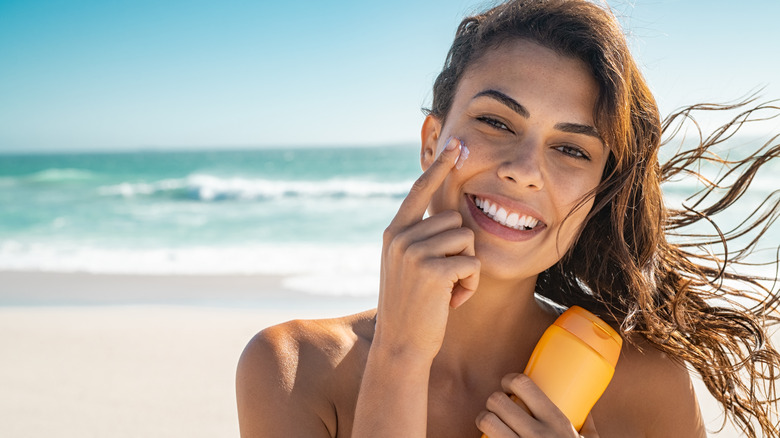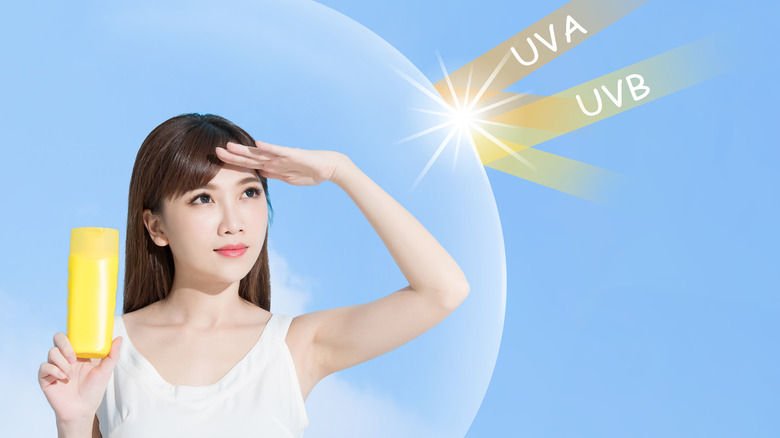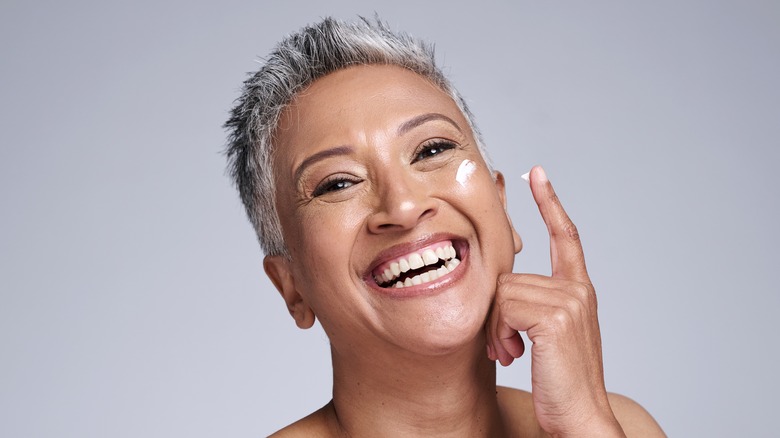The 3 Most Important Letters To Look For On SPF Product Labels
In today's world, sun protection is on people's minds—and store shelves—year-round. SPF, or sun protection factor, is a key term we're used to seeing on various products. According to the FDA, this measurement is a way to assess the amount of sunburn protection, although it's not as straightforward as some people think. The sun's intensity, a person's skin type, and the way the product is applied (and reapplied) also play a role in preventing sunburn.
In addition, higher SPF products don't necessarily equal better protection. For outdoor activities, the Skin Cancer Foundation recommend sticking with at least SPF30. However, they caution that products higher than SPF 50 provide only a minor increase in protecting the skin.
To further complicate matters, chemicals like oxybenzone are a concern when examining an SPF product's ingredients. To sort through all the data, EWG puts together an annual guide outlining their picks for safe, effective sunscreens. In 2022, over 280 products met their criteria.
Besides sunscreen, numerous makeup and even hair and scalp products are advertised as containing SPF, per Byrdie. When reading the labels of these items, keep your eye out for two three-letter abbreviations specifically pertaining to the sun's rays.
Look for broad spectrum protection from UVA and UVB rays
Ultraviolet rays from the sun that reach the Earth's surface come in two types — UVA and UVB. According to the University of Texas MD Anderson Cancer Center, the majority of these—95%—are UVA rays, while only 5% are UVB rays. "UVB causes burning of the skin, whereas UVA causes photoaging such as wrinkles, loss of collagen, and promotes the formation of brown spots (lentigos) on the skin." board-certified dermatologist Dr. Anna Guanche told Byrdie.
Besides sunburn and wrinkles, UVA and UVB rays harm skin cell DNA, increasing a person's risk of developing skin cancer, according to the Skin Cancer Foundation. In addition, because UVA rays are not filtered by glass, it's a good reason to wear sunscreen even indoors.
For optimal sun protection, choose a broad-spectrum product. "Broad spectrum means that it protects you from both UVA and UVB [rays], which are both important not only for skin cancer prevention but also to reduce accelerated aging," dermatologist Dr. Michelle Henry told Everyday Health.
SPF numbers only relate to a formula's ability to block UVB rays. In the US, the FDA notes that looking for the words broad spectrum on the label is the only indication the product will also block UVA rays. By contrast, in the UK, consumers can refer to a star rating to identify the amount of UVA protection. According to the British Skin Foundation, five-star products offer ultra protection.
Rely on sunscreen rather than makeup for sun protection
When it comes to protecting your skin from sun damage, makeup with SPF is not equal to a broad-spectrum sunscreen. While some makeup products, such as Clinique's Even Better foundation, are labeled as broad-spectrum, the difficulty lies in the application. Frequently, people don't apply a sufficient amount of SPF makeup for adequate protection. Dr. Sonia Batra told Women's Health that people need approximately a nickel-sized amount of face makeup to get the listed SPF protection. In her experience, users aren't putting on this much makeup.
Instead, make applying sunscreen the first step in your makeup routine. Aim to use a quarter to half teaspoon to cover your face, neck, and ears, says dermatologist Dr. Cynthia Bailey. Afterward, wait two minutes or more before applying other products. According to dermatologist Dr. Kiran Mian, this lessens the chances of ingredients in makeup and sunscreen combining while wet and impacting SPF protection (via The New York Times).
Next, apply your SPF makeup products as an added bonus. "Think of makeup with SPF like the cherry on top of the sundae. But without the ice cream, it's not a sundae at all," board-certified dermatologist Dr. Joshua Zeichner told Today. Even so, it's important to note that wearing multiple SPF products does not equal a higher SPF overall. "Since you're not applying as much as you should be, to begin with, you're not actually getting any added effect," notes Zeichner.


